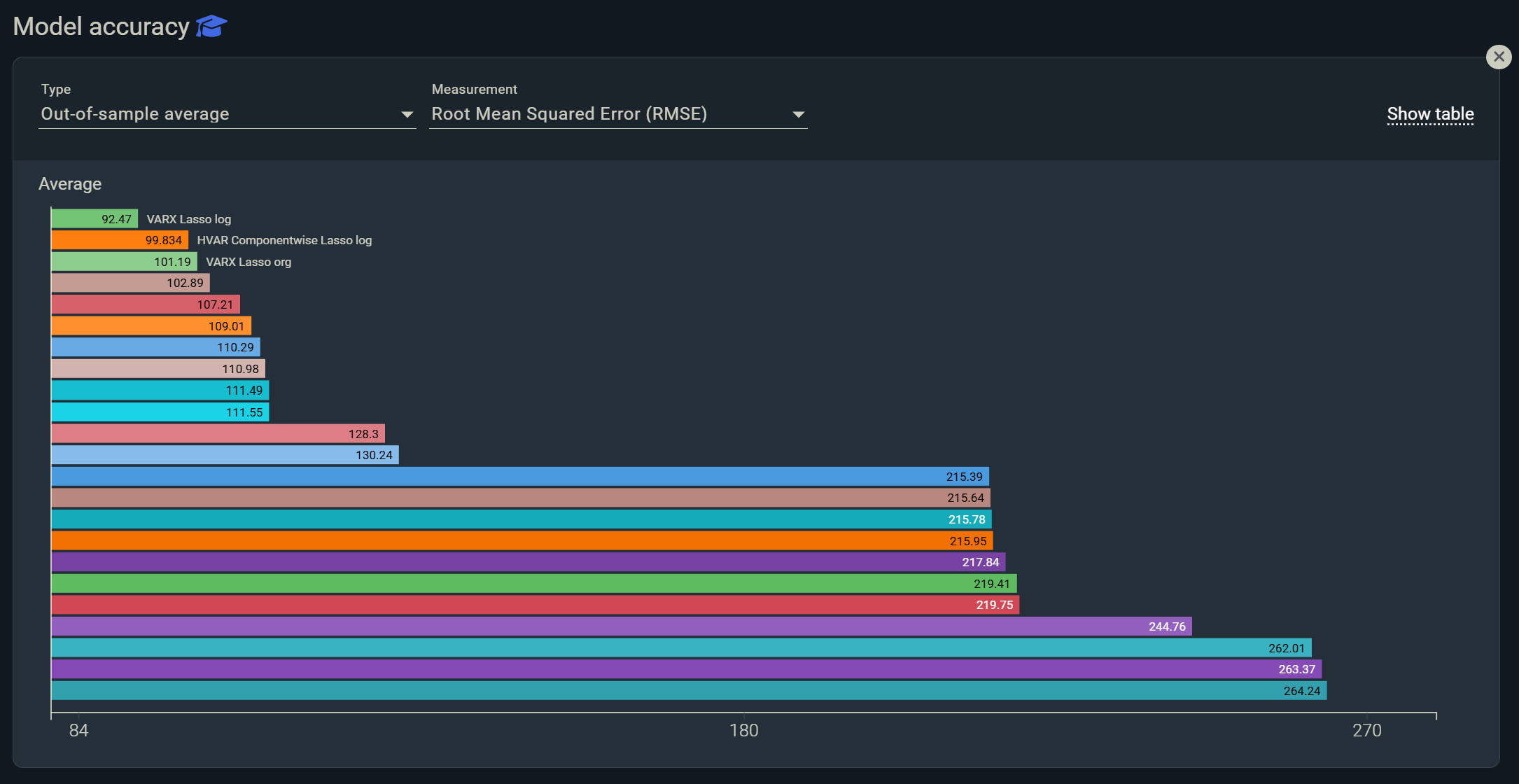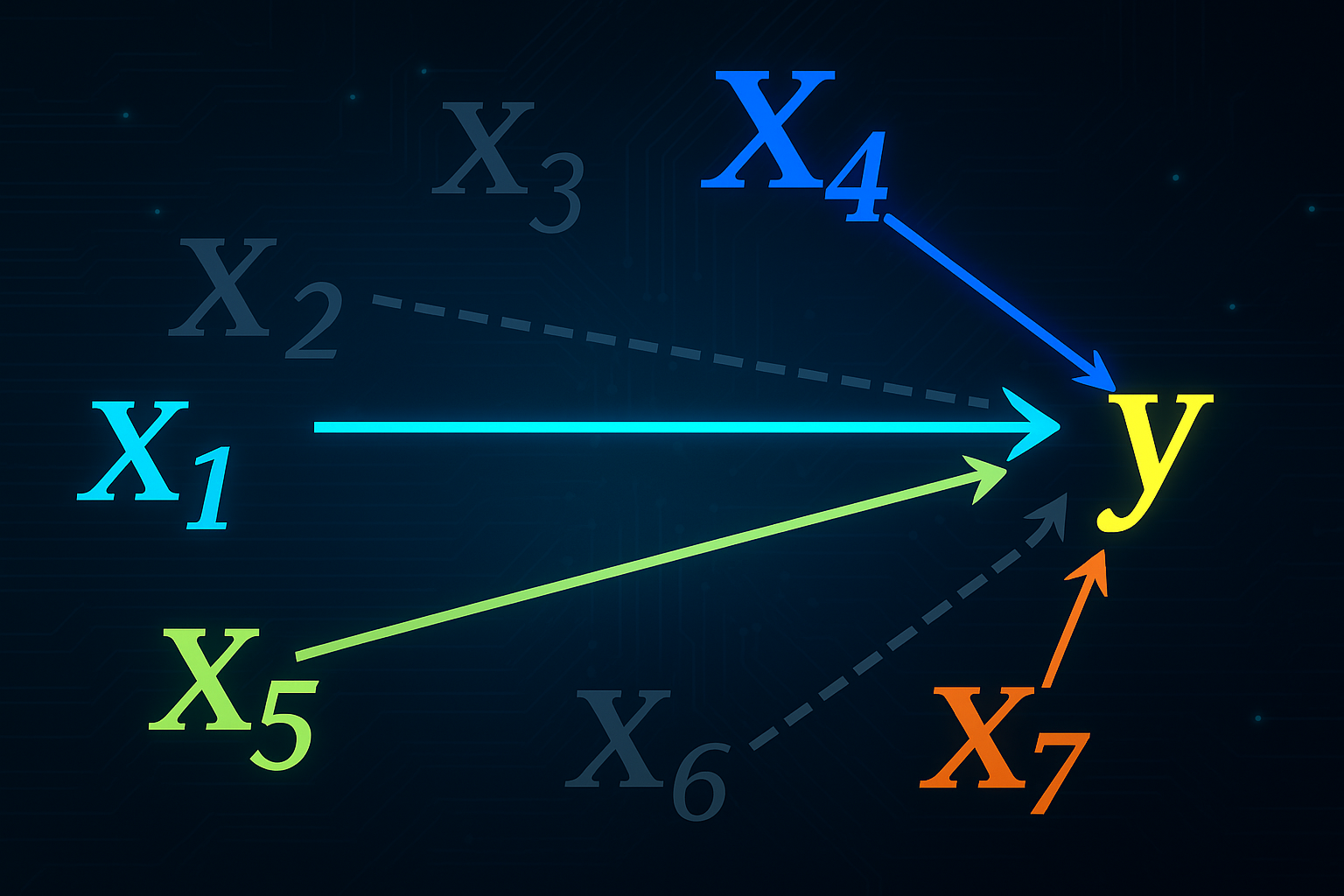Economic forecasting has advanced quickly, driven by richer data, better algorithms, and rigorous evaluation. Three practices consistently improve accuracy. First, combine multiple models, since forecast combinations often beat any single model in out-of-sample testing, a finding dating back to Bates and Granger and confirmed by modern reviews and textbooks (overview, textbook chapter). Second, select predictors systematically using methods that guard against overfitting. Third, for nowcasting, exploit high-frequency indicators with mixed-frequency methods such as MIDAS and MF-VAR, which preserve information that time aggregation throws away (Ghysels et al., Giannone–Reichlin–Small). For scenario analysis, conditional forecasting in VAR and DSGE models following the Bayesian framework of Waggoner and Zha enables what-if paths constrained by policy or macro assumptions.
1) Indicio
Indicio is a no-code forecasting platform designed for economists who need robust model selection, broad model coverage, and fast scenario analysis. It automates variable selection across large data sets, evaluates a wide portfolio of econometric, time-series, and ML models, and weights them into ensembles. For nowcasting, it supports mixed-frequency modeling to ingest daily and weekly indicators in monthly or quarterly forecasts. Scenario analysis uses the conditional-forecasting framework introduced by Waggoner and Zha, so you can condition paths on policy or market assumptions and generate distributions in a few clicks. The vendor reports users achieve large nowcasting improvements and guarantees at least 30 percent accuracy gains from its automated selection and ensembles (nowcasting overview).
Pros:
- Automated variable selection plus large model library with weighted ensembles, targeting accuracy uplift.
- Mixed-frequency nowcasting with high-frequency data and evidence of sizable gains.
- Scenario analysis via Waggoner–Zha conditional forecasts, implemented through a user-friendly UI.
Cons:
- Costs more than open-source packages.
- You cannot code your own models, although you can tune model settings.
- Requires an internet connection.
2) EViews
EViews remains a staple for applied macroeconomists who need deep time-series and econometric tooling in a point-and-click environment. It offers ARIMA/ETS, VAR/VEC, state-space, Bayesian routines, and native MIDAS regressions so you can blend quarterly targets with monthly or daily indicators without pre-aggregation. Recent releases added enhancements that fuse MIDAS with GETS-style auto-search to select relevant high-frequency predictors for nowcasting workflows. These features make it straightforward to test many specifications, compare accuracy, and assemble a working ensemble strategy (EViews MIDAS overview, EViews 12 enhancements).
Pros:
- Native MIDAS and mixed-frequency data handling for practical nowcasting builds.
- Broad econometric coverage, including VAR/VEC and state-space.
- UI-driven model comparison that supports ensemble workflows.
Cons:
- Limited built-in automated ensemble weighting compared to specialized platforms.
- Heavy scripting or manual setup needed for large-scale model grids.
- Collaboration and versioning are less modern than cloud-native tools.
3) MATLAB Econometrics Toolbox (+ community toolboxes)
MATLAB’s Econometrics Toolbox provides a mature environment for VAR/VEC, state-space, Bayesian VAR, and constrained or conditional forecasting. Official examples show how to generate conditional responses in VARs, which underpins disciplined scenario analysis. For mixed-frequency modeling, practitioners commonly use MATLAB-based toolboxes such as the JSS mixed-frequency state-space package by Brave and coauthors or the MIDAS toolbox seeded by Ghysels, enabling MIDAS and MF-state-space workflows alongside MATLAB’s optimization and visualization stack (conditional forecasts example, mixed-frequency state-space guide, MIDAS toolbox).
Pros:
- End-to-end environment for econometrics, simulation, and conditional scenario analysis.
- Rich ecosystem of mixed-frequency and Bayesian VAR add-ons.
- Strong tooling for automation, reproducibility, and visualization.
Cons:
- Licensing costs add up with multiple toolboxes.
- Mixed-frequency features often rely on add-ons or community code.
- Steeper learning curve than point-and-click suites.
4) SAS Econometrics (SAS/ETS)
SAS/ETS offers industrial-grade time-series and econometric procedures, including state-space, UCM, ARIMA/ARIMAX, VAR/MAX, and Bayesian variants. Its documentation includes worked examples for conditional forecasts and scenario analysis with VARMAX, making it suitable for policy what-ifs and stress tests. In large organizations, SAS’s governance, scheduling, and audit trails help move forecasts from prototype to production (conditional forecasts and scenarios in VARMAX, example).
Pros:
- Built-in conditional forecasting and scenario workflows for VAR/MAX.
- Enterprise-grade deployment, logging, and governance.
- Wide library for classical and state-space models with exogenous drivers.
Cons:
- High total cost of ownership.
- Less flexible for cutting-edge ML compared to Python/R ecosystems.
- GUI experience feels dated relative to newer platforms.
5) OxMetrics (PcGive + Autometrics)
OxMetrics with PcGive focuses on econometrically disciplined modeling. Autometrics implements the general-to-specific approach for automated variable and lag selection, helping you traverse huge model spaces while preserving diagnostic rigor, a strong answer to the which variables should go into the model question. PcGive covers single- and multi-equation systems, VARs, cointegration, and more, letting you evaluate many structures and then combine or compare results to stabilize accuracy (PcGive manual noting Autometrics integration, Autometrics principles).
Pros:
- Industrialized automatic variable selection via Autometrics/GETS.
- Strong diagnostics for misspecification, stability, and outliers.
- Suited to building defensible models analysts can explain.
Cons:
- Fewer out-of-the-box ML options and ensembles.
- Mixed-frequency support relies on workflows rather than dedicated modules.
- Smaller ecosystem of third-party extensions than MATLAB/R.
6) Dynare
Dynare is the leading open-source environment for DSGE modeling and Bayesian macroeconometrics. It supports conditional forecasting and scenario analysis by constraining paths of selected variables or shocks, which is ideal for policy simulations and forward-guidance exercises. Economists can integrate DSGE and BVAR elements to compare theory-consistent projections with data-driven alternatives and even blend them to stabilize accuracy (Dynare manual: forecasting).
Pros:
- State-of-the-art DSGE and Bayesian workflows for policy-grade scenarios.
- Open source, with a large academic and central bank user base.
- Flexible for constrained paths and multi-shock simulations.
Cons:
- Steep learning curve and code-first workflow.
- Limited GUI and reporting compared to commercial suites.
- Mixed-frequency handled indirectly via custom state-space setups.
7) Stata
Stata is a versatile econometrics workbench with solid time-series coverage, including VAR/VECM and Bayesian VARs for multi-variable forecasting. It supports dynamic and Bayesian forecasting workflows and integrates easily with reproducible scripts for robust backtesting and evaluation. For scenario analysis, you can condition forecasts through model structure and exogenous paths, and leverage the Bayesian toolchain for uncertainty quantification (Bayesian VAR forecasting in Stata).
Pros:
- Reliable VAR/VEC and Bayesian VAR workflows with uncertainty analysis.
- Strong data management and reproducible do-file pipelines.
- Good documentation and community support.
Cons:
- No native turnkey MIDAS module for mixed-frequency nowcasting.
- Fewer automated ensemble utilities out-of-the-box.
- Visualization and dashboards less modern than specialized platforms.
8) R ecosystem (midasr, vars, BVAR and more)
R offers a best-in-class open-source stack for economic forecasting. The midasr package implements MIDAS and U-MIDAS for mixed-frequency nowcasting, vars provides VAR/SVAR/VECM with forecasting and IRFs, and BVAR supports Bayesian VARs with scenario analysis methods. Combined with stacking packages, you can build large model grids, perform variable selection, and ensemble across classical and ML models. It is powerful, extensible, and production-ready with the right engineering (midasr JSS article, vars CRAN manual, BVAR CRAN manual).
Pros:
- First-class mixed-frequency nowcasting with MIDAS/U-MIDAS.
- Broad econometric coverage plus modern ML and stacking libraries.
- Lowest cost and largest extensibility via packages.
Cons:
- Code-heavy, requires engineering for governance and MLOps.
- Quality varies across packages, raising validation overhead.
- No single vendor for support, unless you contract it.
Why these features matter right now
- Variable selection that scales
Bayesian variable selection, stepwise search, penalization, and factor-based screening reduce false positives and stabilize out-of-sample error when the candidate predictor set is large (Indicio: variable selection). - Ensamble over single models
Decades of evidence show combinations typically outperform individual specifications across conditions, reducing variance and model risk (50-year review, textbook note). - Mixed-frequency for nowcasting
MIDAS and MF-VAR use all timely daily or weekly signals without information-destroying aggregation, and recent work shows material accuracy gains in practice (Ghysels et al., ECB applications, Cleveland Fed 2024). - Scenario analysis that is principled
Conditional forecasts following the Waggoner–Zha framework let you impose soft or hard future paths and generate distributions for what-if policymaking (Waggoner and Zha, ECB large-VAR scenarios).



